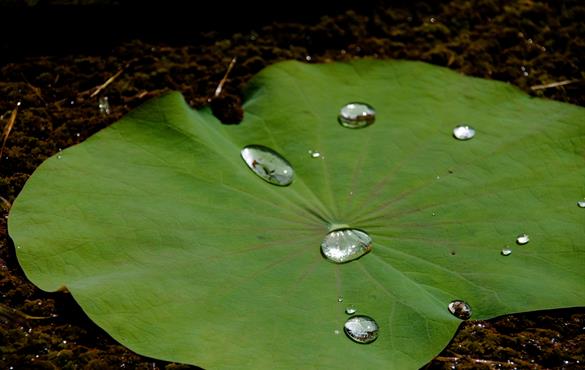Plants model more efficient cooling method
McKelvey Engineering mechanical engineer creates bioinspired evaporation technique

When drops of water touch the surface of a lotus flower leaf, they form beads and roll off, collecting dust particles along the way. In contrast, water droplets on a rose petal also form beads, but remain pinned to the petal's surface. A mechanical engineer at Washington University in St. Louis combined the two concepts to find a more efficient way for droplets to evaporate from a surface.
Patricia Weisensee, assistant professor of mechanical engineering & materials science in the McKelvey School of Engineering, initially planned to establish a pattern on a surface that would both repel liquid, similar to the lotus leaf, or pin droplets, similar to the rose petal, to influence wetting during droplet impact, such as during rain. Like the lotus leaf, when water impacts a repellant or superhydrophobic surface, droplets easily rebound, similar to rain on treated windshields. In heat transfer and evaporation, these superhydrophobic surfaces are very inefficient due to a short contact time between the water and the surface. Conversely, when liquid comes in contact with a hydrophilic surface that can be wetted, it spreads over the surface, forms a liquid puddle and takes a long time to evaporate. Weisensee wanted to create a surface with both repelling and wetting properties that would create small sub-droplets, combining the advantages of both types of surfaces: droplet pinning and evaporation on the wetting surface without the risk of flooding the entire repelling surface. She then observed their behavior to learn more about evaporation as a cooling method for thermal management of high-tech electronic devices.
Results of her work were published online Dec. 20 in Langmuir.
Weisensee and her co-authors, Wenliang Qi, a visiting doctoral student from Harbin University in China, and Junhui Li, a McKelvey Engineering doctoral student in mechanical engineering & materials science, placed a single drop of water on a heated horizontal surface that they had designed to have both wetting and repelling properties. Using optical and infrared imaging, they studied the drop's behavior, including how its size and shape evolved as well as its temperature, heat transfer and evaporation rate.
"On the horizontal surface, everything is nice and symmetrical and behaves the way we would expect it to behave," Weisensee said. "But we decided to put a droplet on a vertical surface, and we saw very different behavior."
The team created a surface that had a slightly hydrophilic spot in the center of a superhydrophobic surface that kept the drop pinned to the surface. Without the custom pattern, gravity would have caused the drop to roll down the surface.
"What we saw was that suddenly the thermal signature was not symmetrical anymore, which was the opposite of what we expected," Weisensee said. "We saw lower temperatures at the bottom of the droplet and higher temperatures at the top, which meant that the heat transfer was higher in the bottom than the top despite a higher contact angle and an evaporation-limiting 'wedge effect' of the surrounding air."
They added small particles to the droplet to be able to see the flow of the convective currents inside.
"We see that the flow goes from the bottom of the drop to the top, which doesn't make sense from a buoyancy viewpoint because warm water is lighter than cold water," she said. "It should self-stabilize with the colder water staying at the bottom. So clearly the answer to this apparent contradiction must be lying somewhere else."
Using computational fluid dynamic simulations, the team found that the vapor-saturated air on the heated vertical surface forms a flame shape around the droplet because of the lower density of moist air.
"This put more vapor on the top because of the flow of the vapor around the droplet," Weisensee said. "When there is more vapor around the top of the droplet, it's not as easy for the water to evaporate because there is already so much vapor, and hence the evaporation rate is limited. At the bottom, however, you constantly get rid of the vapor because it will just rise to the top."
Because of the modified flow and thermal signature, the evaporation of the vertical droplet is about 10% more efficient than a horizontal droplet, Weisensee said.
Insights from this work could help to guide future design of spray cooling devices or be used to change particle deposition patterns during evaporation-based fabrication techniques.
Funding for this research was provided by Washington University in St. Louis and China Scholarship Council (Qi).
Qi W, Li J, Weisensee P. Evaporation of sessile water droplets on horizontal and vertical bi-phobic patterned surfaces. Langmuir. Published online Dec. 20, 2019. DOI: https://doi.org/10.1021/acs.langmuir.9b02853




